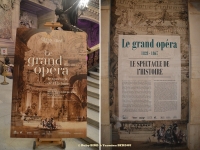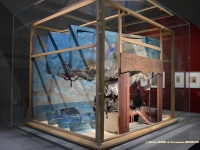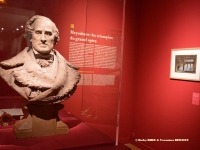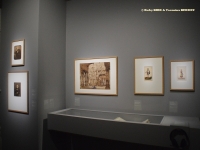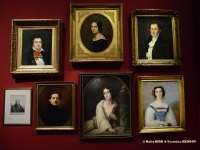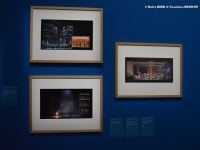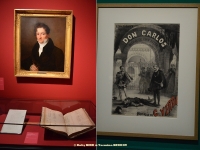Arts
PALAIS GARNIER - LE SPECTACLE DE L HISTOIRE EXHIBITION
LE GRAND OPERA 1828 - 1867
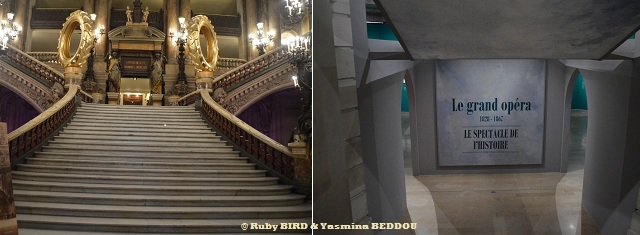
LE GRAND OPERA 1828 - 1867 (Source: © Ruby BIRD & Yasmina BEDDOU)
USPA NEWS -
THE PALAIS GARNIER or Opéra Garnier is an Opera House at the Place de l'Opéra in the 9th arrondissement of Paris, France. It was built for the Paris Opera from 1861 to 1875 at the Behest of Emperor Napoleon III. Initially referred to as "Le Nouvel Opéra de Paris" (The New Paris Opera), it soon became known as the Palais Garnier, "in Acknowledgment of its Extraordinary Opulence" and the Architect Charles Garnier's Plans and Designs, which are representative of the Napoleon III Style. It was the Primary Theatre of the Paris Opera and its Associated Paris Opera Ballet until 1989, when a New Opera House, the Opéra Bastille, opened at the Place de la Bastille. The Company now uses the Palais Garnier mainly for Ballet. The Theatre has been a Monument Historique of France since 1923.
THE PALAIS GARNIER or Opéra Garnier is an Opera House at the Place de l'Opéra in the 9th arrondissement of Paris, France. It was built for the Paris Opera from 1861 to 1875 at the Behest of Emperor Napoleon III. Initially referred to as "Le Nouvel Opéra de Paris" (The New Paris Opera), it soon became known as the Palais Garnier, "in Acknowledgment of its Extraordinary Opulence" and the Architect Charles Garnier's Plans and Designs, which are representative of the Napoleon III Style. It was the Primary Theatre of the Paris Opera and its Associated Paris Opera Ballet until 1989, when a New Opera House, the Opéra Bastille, opened at the Place de la Bastille. The Company now uses the Palais Garnier mainly for Ballet. The Theatre has been a Monument Historique of France since 1923.
The Palais Garnier has been called "probably the Most Famous Opera House in the World, a Symbol of Paris like Notre Dame Cathedral, the Louvre, or the Sacré Coeur Basilica... The Palais Garnier also houses the Bibliothèque-Musée de l'Opéra de Paris (Paris Opera Library-Museum), which is managed by the Bibliothèque Nationale de France and is included in Unaccompanied Tours of the Palais Garnier.
The Façade and the Interior followed the Napoleon III Style Principle of leaving no Space without Decoration. Garnier used Polychromy, or a Variety of Colors, for Theatrical Effect, achieved Different Varieties of Marble and Stone, Porphyry, and Gilded Bronze. The Façade of the Opera used Seventeen Different Kinds of Material, arranged in very elaborate Multicolored Marble Friezes, Columns, and Lavish Statuary, many of which portray Deities of Greek Mythology.... The Principal Façade is on the South Side of the Building, overlooking the Place de l'Opéra and terminates the Perspective along the Avenue de l'Opéra. Fourteen Painters, Mosaicists and Seventy-Three Sculptors participated in the Creation of its Ornamentation
In 1821 the Opéra de Paris had moved into the Temporary Building known as the Salle Le Peletier on the rue Le Peletier. Since then a New Permanent Building had been desired.... With the Establishment of the Second Empire in 1852 and Georges-Eugène Haussmann's Appointment as Prefect of the Seine in June 1853, Interest in a New Opera House revived. There was an Attempted Assassination of Emperor Napoleon III at the Entrance to the Salle Le Peletier on 14 January 1858. The Salle Le Peletier's constricted Street Access highlighted the need for a Separate, more Secure Entrance for the Head of State. This Concern and the Inadequate Facilities and Temporary Nature of the Theatre gave added Urgency to the Building of a New State-Funded Opera House. By March, Haussmann settled on Rohault de Fleury's proposed Site off the Boulevard des Capucines, although this Decision was not announced Publicly until 1860. A New Building would help resolve the Awkward Convergence of Streets at this Location, and the Site was Economical in Terms of the Cost of Land....
The Opera Library and Archives were founded in 1866 to ensure the Organization and Conservation of Historical and Administrative Documents owned by the Opera since the Creation of the Académie Royale de Musique et de Danse by Louis XIV. It was originally placed Under the Patronage of the Ministry of Fine Arts, attached in 1935 to the National Library and then integrated in the Music Department in 1942. The Library keeps Musical, Iconographic and Archive Records from the Activity of the Opéra and the Opéra Comique and all Documents regarding Lyric Art, Dance and Circus. The Museum is open to the Public and is accessible to the Readers of the Research Library.
350 YEARS OF THE OPERA DE PARIS
The Celebrations got underway with an Inaugural Gala on 30 December Last Year, and continue at the Palais Garnier throughout 2019. The Exhibition titled “˜Un Air d´Italie - L´Opéra de Paris de Louis XIV à la Révolution´ (A certain Air of Italy. The Paris Opera from Louis VIX to the Revolution) organized with the Bibliothèque Nationale de France (BNF) retraces a Large Chunk of the Paris Opera´s History from Louis XIV´s Reign all the Way to the French Revolution. The Paris Opera is also going Off-Site to celebrate its Anniversary, with the “˜Edgar Degas à l´Opéra´ Exhibition at the Musée d´Orsay, the "Opéra Monde" at Centre Pompidou-Metz and "Habiller l'Opéra" at CNCS of Moulins.... From October 24, 2019 To February 2, 2020 the Library-Museum of the Opera de Paris will be holding an Exhibition called "Le Grand Opéra, 1828-1867. Le Spectacle de l'Histoire" exploring Events during this Specific Time.
The Celebrations got underway with an Inaugural Gala on 30 December Last Year, and continue at the Palais Garnier throughout 2019. The Exhibition titled “˜Un Air d´Italie - L´Opéra de Paris de Louis XIV à la Révolution´ (A certain Air of Italy. The Paris Opera from Louis VIX to the Revolution) organized with the Bibliothèque Nationale de France (BNF) retraces a Large Chunk of the Paris Opera´s History from Louis XIV´s Reign all the Way to the French Revolution. The Paris Opera is also going Off-Site to celebrate its Anniversary, with the “˜Edgar Degas à l´Opéra´ Exhibition at the Musée d´Orsay, the "Opéra Monde" at Centre Pompidou-Metz and "Habiller l'Opéra" at CNCS of Moulins.... From October 24, 2019 To February 2, 2020 the Library-Museum of the Opera de Paris will be holding an Exhibition called "Le Grand Opéra, 1828-1867. Le Spectacle de l'Histoire" exploring Events during this Specific Time.
Source : Vernissage Exhibition "Le Grand Opéra, 1828-1867. Le Spectacle de l'Histoire". On October 23, 2019.
Ruby BIRD
http://www.portfolio.uspa24.com/
Yasmina BEDDOU
http://www.yasmina-beddou.uspa24.com/
Ruby BIRD
http://www.portfolio.uspa24.com/
Yasmina BEDDOU
http://www.yasmina-beddou.uspa24.com/
2020 February 2 2019 October 24 Bibliotheque Musee De L Opera Bnf Le Grand Opera Le Spectacle De L Histoire Ballet Paris Opera Garnier Yasmina Beddou Ruby Bird
Liability for this article lies with the author, who also holds the copyright. Editorial content from USPA may be quoted on other websites as long as the quote comprises no more than 5% of the entire text, is marked as such and the source is named (via hyperlink).

